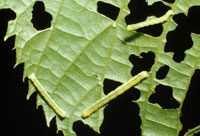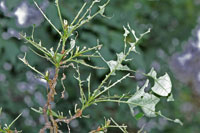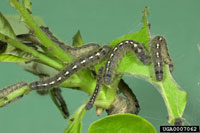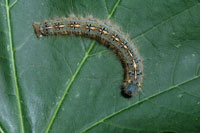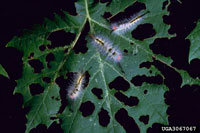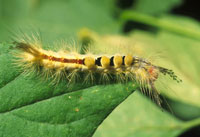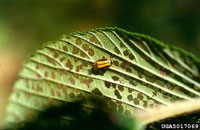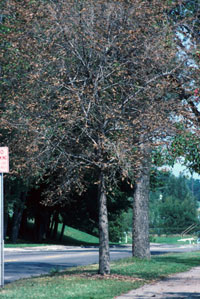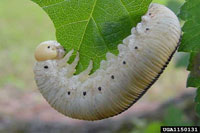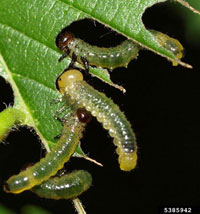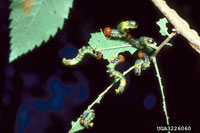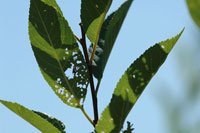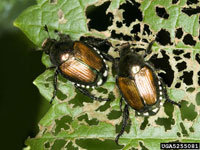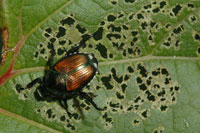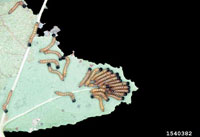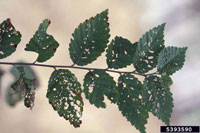Extension > Garden > Diagnose a problem > What's wrong with my plant? > Deciduous Trees > Elm > Holes in leaves or parts of leaves missing
Elm > Leaves > Holes in leaves or parts of leaves missing
1 of 9
Spiny elm caterpillar (Mourning cloak butterfly)
Nymphalis antiopa
- Larvae feed in groups, eating leaves; they can defoliate entire branches
- Mostly black with scattered white spots and a single row of red spots and black spines along its body
- Larvae feed in May and June and again in July or August by a second generation
- Turn into mourning cloak butterflies
- More information on Spiny elm caterpillar
2 of 9
Cankerworms
Alsophila pometaria (fall) and Paleacrita vernata (spring)
- Larvae chew between the major veins at first, eventually chewing everything except midveins
- Defoliation typically light to moderate, although it can be severe
- Smooth-bodied, light green to brown, 2 inches long when fully grown; moves in characteristic looping motion
- Damage occurs late April/early May until June
- More information on Cankerworms
3 of 9
Forest tent caterpillar
Malacosoma disstria
- Larvae chew entire sections of leaves, sometimes leaving some major veins; defoliation often severe
- Hairs along sides of body; blue and black with characteristic footprint shaped white markings on top of body
- Damage occurs May and June
- More information on Forest tent caterpillar
4 of 9
Whitemarked tussock moth
Orygia leucostigma
- Young larvae windowpane feed (i.e. feed on one layer of leaf tissue between veins) giving them a lacelike appearance
- Older larvae consume entire leaves except the midrib and large veins
- Caterpillars have a red-orange head with two sets of black tufts near the head; yellowish hairy body with distinct tufts of hair resembling a toothbrush on top of the body
- Full grown larvae are 1 ¼ inches long
- Damage by two generations; first from May to June and a second one from August to September
- More information on Whitemarked tussock moth
5 of 9
Elm leaf beetle
Pyrrhalta luteola
- Adults eat small, nearly circular holes in the leaves during spring
- During late spring larvae windowpane feed, i.e. eat one layer of leaf tissue between the veins leaving the upper leaf surface intact
- Entire leaf canopy can be affected so may look brown from a distance
- Adults are ¼ to 3/8 inch long and yellow with black stripes along length of wing covers
- Larvae up to 1/2 inch long; dull yellow with lateral black stripes
- Siberian elms are most preferred host followed by American elms
- More information on Elm leaf beetle
6 of 9
Elm sawfly
Cimbex americana
- Larvae chew on leaf edges, as they mature entire leaves are consumed
- Full-grown larva is almost wrinkly; 2 inches long; yellowish to greenish with black stripe down its back; several whitish spots giving it a grainy appearance
- Larvae present in June and feed until late July or August
- More information on Elm sawfly
7 of 9
Japanese beetle
Popillia japonica
- Skeletonizes leaves, i.e. chews leaf tissue between the veins creating a lacelike appearance
- Attacks are common in sunny locations starting at the top of the plant and working down as they feed
- Adults are metallic green; bronze wings; white tufts of “hair” along their sides
- Beetles present as early as late June and are active through September
- More information on Japanese beetle
8 of 9
Redhumped caterpillar
Schizura concinna
- Larvae eat entire leaves, leaving only the midvein
- Red head with a wavy black, yellow, and white striped body and a red projection (hump) on the thorax behind the head; 1 1/3 inches long when fully grown
- Damage occurs in August and September
- More information on Redhumped caterpillar
9 of 9
Elm flea weevil
Orchestes alni
- Adults eat on leaf undersides creating small holes in leaves
- Larvae create blotch mines at tips of leaves
- Adults are brown with black heads, black spots on wings, long snout, 1/8 inch long
- Preferred hosts are Siberian and hybrid elms
- More information on Elm flea weevil







